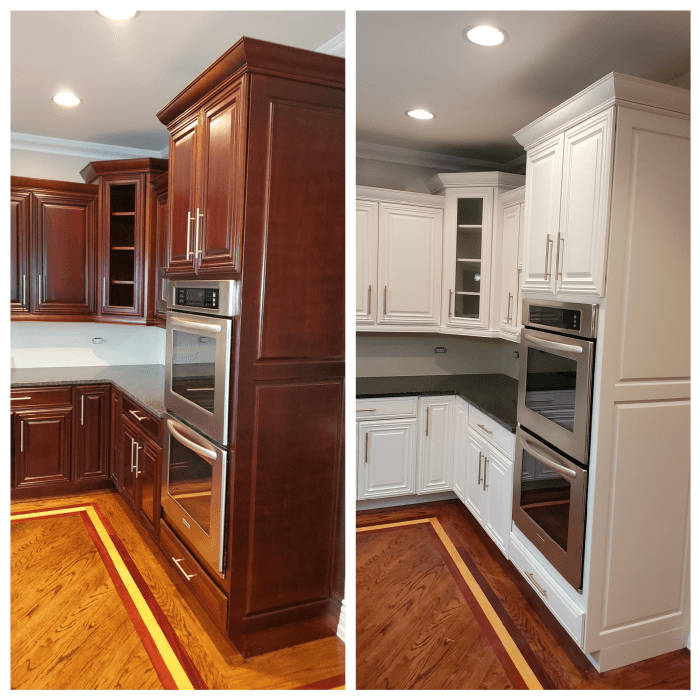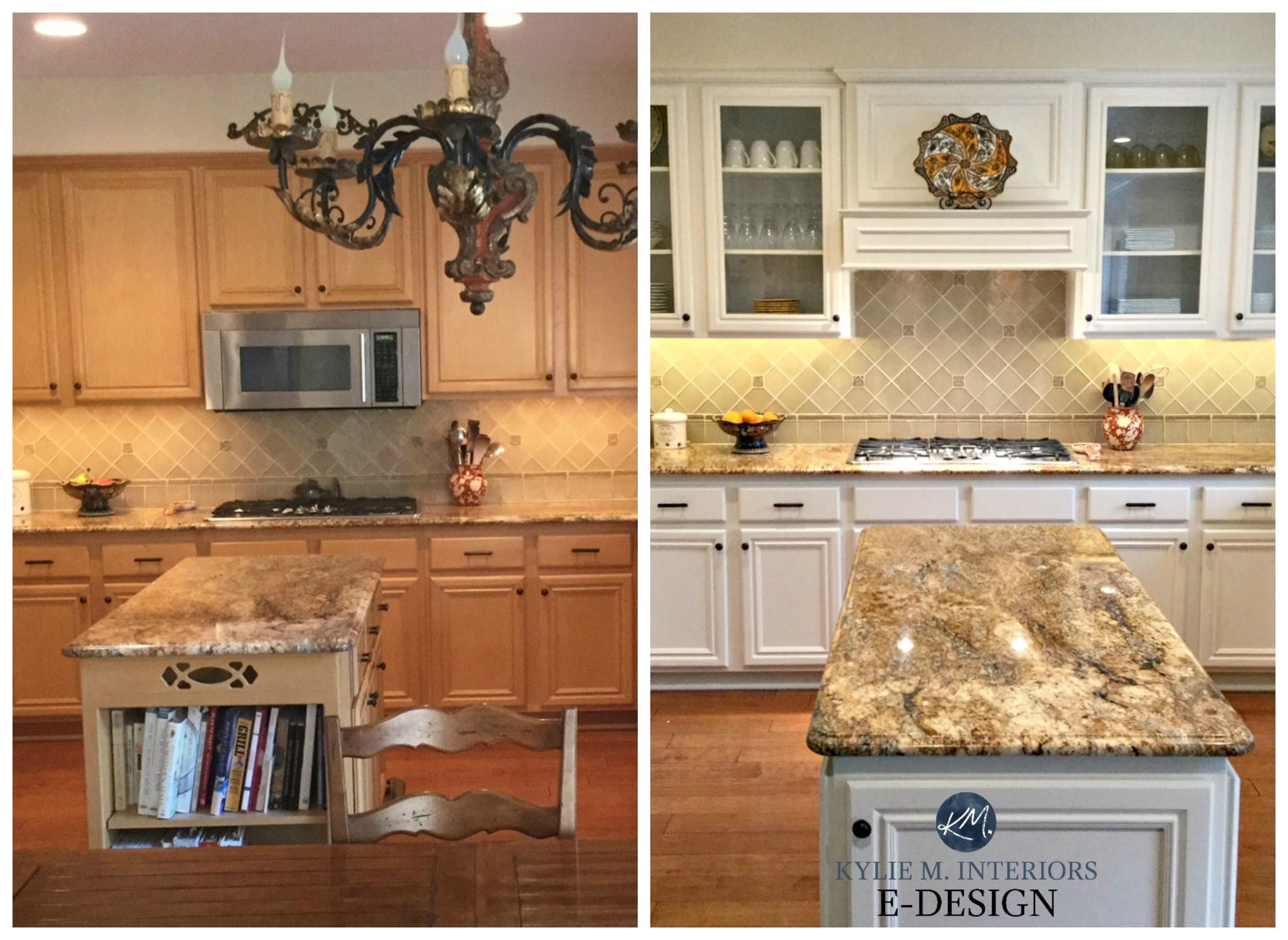The Transformation: Painting Dark Cabinets White Before And After

Our kitchen, once a haven of dark, brooding cabinetry, was in dire need of a makeover. The rich mahogany finish, while elegant, cast a somber mood over the space, making it feel cramped and closed off. The dark cabinets, paired with the existing granite countertops, created a visually heavy atmosphere that wasn’t conducive to a light and airy kitchen. We longed for a brighter, more welcoming space that would inspire culinary creativity and joyful gatherings.
Before the Transformation
The “before” image captures the essence of our kitchen’s pre-transformation state. The dark cabinets dominated the space, swallowing the natural light that streamed in from the window. The overall design aesthetic was traditional, with a touch of formality. The dark cabinets, coupled with the granite countertops, created a visually heavy atmosphere that felt a bit dated and uninviting. The dark hues made the kitchen feel smaller than it actually was, and the lack of contrast made the space appear somewhat flat.
After the Transformation
Our vision was to transform the kitchen into a bright, airy, and inviting space that reflected our modern sensibilities. We envisioned a clean, crisp aesthetic that would enhance the natural light and create a sense of openness. Painting the cabinets white was the key to achieving this transformation. The “after” image reveals the dramatic impact of this simple yet effective change. The white cabinets instantly brighten the space, reflecting light and making the kitchen feel larger and more welcoming. The white cabinets create a stunning contrast against the dark granite countertops, adding visual interest and depth to the space. The overall aesthetic is now modern and contemporary, reflecting our personal style and creating a space that is both functional and visually appealing.
The Painting Process

Painting dark cabinets white is a rewarding project that can dramatically transform your kitchen or bathroom. With careful preparation, the right tools, and a systematic approach, you can achieve a professional-looking finish that will last for years.
Essential Tools and Materials
A successful paint job requires the right tools and materials. Here’s a list of what you’ll need:
- Paint: Choose a high-quality, durable paint specifically designed for cabinets. Acrylic latex paint is a popular choice for its ease of application, durability, and low VOCs.
- Primer: A primer is essential for creating a smooth, even surface for the paint to adhere to, especially when painting over dark surfaces. Choose a primer specifically formulated for cabinets or wood.
- Paintbrushes: Use a high-quality brush with angled bristles for applying paint to the cabinet surfaces.
- Paint Roller: A roller with a short nap is ideal for applying paint to large flat surfaces, such as cabinet doors.
- Paint Tray: A paint tray with a liner is essential for holding and dispensing paint.
- Sandpaper: Use fine-grit sandpaper (120-180 grit) for smoothing the surfaces before priming and painting.
- Drop Cloths: Protect your floors and surrounding areas from paint spills and splatters.
- Painter’s Tape: Use painter’s tape to mask off areas that you don’t want to paint, such as countertops, walls, and hardware.
- Cleaning Supplies: You’ll need cleaning supplies, such as dish soap, water, and a microfiber cloth, to clean the cabinets before painting.
- Safety Gear: Wear safety gear, such as gloves, a mask, and eye protection, to protect yourself from paint fumes and dust.
Surface Preparation
Proper surface preparation is crucial for a smooth and durable paint finish. This involves cleaning, sanding, and priming the cabinets.
- Cleaning: Thoroughly clean the cabinets with a solution of dish soap and water. This removes dirt, grease, and grime that can interfere with paint adhesion.
- Sanding: Sand the cabinets with fine-grit sandpaper (120-180 grit) to smooth out any imperfections and create a uniform surface for the primer.
- Priming: Apply a coat of primer to the cabinets. This creates a barrier between the old paint and the new paint, ensuring that the paint adheres properly.
Painting Techniques
There are different painting techniques for achieving a smooth and professional finish.
- Applying Paint: Apply paint in thin, even coats, using a high-quality brush or roller. Avoid overloading the brush or roller with paint, as this can cause drips and runs.
- Cabinet Doors and Drawer Fronts: When painting cabinet doors and drawer fronts, it’s helpful to remove the hardware and lay the doors flat on a drop cloth. This allows you to paint the entire surface evenly.
- Moldings: Use a small brush to paint moldings and trim.
Choosing the Right Paint
Choosing the right paint type and color is essential for a durable and long-lasting finish.
- Paint Type: Acrylic latex paint is a popular choice for cabinets due to its ease of application, durability, and low VOCs.
- Color: Choose a white paint that complements your kitchen or bathroom design.
Applying Multiple Coats
Applying multiple coats of paint is essential for optimal coverage and a smooth finish.
- First Coat: Apply the first coat of paint evenly to the cabinets. Let it dry completely before applying the second coat.
- Second Coat: Apply the second coat of paint in the same direction as the first coat. Let it dry completely before applying a third coat if needed.
The Impact

Painting dark cabinets white can dramatically transform the look and feel of your kitchen or any space. It’s a simple yet effective way to create a fresh, modern aesthetic, and it can significantly impact the overall ambiance of the room.
Brightening & Enlarging Spaces
White cabinets have a remarkable ability to reflect light, making a room feel brighter and more spacious. This is particularly beneficial in smaller kitchens or rooms with limited natural light. The increased reflectivity of white surfaces can visually expand the space, creating a sense of openness and airiness. Imagine a small kitchen with dark cabinets; it might feel cramped and gloomy. Now, picture the same kitchen with white cabinets; the space instantly feels larger, brighter, and more inviting.
Aesthetic Differences & Versatility
Dark cabinets create a more traditional and formal ambiance. They can be elegant and sophisticated, but they can also make a room feel smaller and darker. White cabinets, on the other hand, offer a clean, contemporary look that is highly versatile. They can easily adapt to various design styles, from minimalist and modern to farmhouse and traditional. The versatility of white allows for a wider range of design choices, making it a popular option for homeowners seeking a timeless and adaptable aesthetic.
Complementary Design Elements
White cabinets provide a neutral backdrop that complements a wide range of countertop materials, backsplashes, and flooring choices.
- With white cabinets, you can opt for bold and colorful countertops, like granite or quartz, without overwhelming the space.
- White cabinets pair beautifully with subway tile backsplashes, creating a classic and timeless look.
- They can also complement natural stone flooring, adding warmth and texture to the space.
Maintenance & Challenges, Painting dark cabinets white before and after
While white cabinets offer a fresh and bright aesthetic, they do require more maintenance than their darker counterparts.
- White surfaces show dirt and smudges more readily, so regular cleaning is essential.
- White cabinets are also more susceptible to stains, especially from spills and food splatters.
However, with proper care and cleaning, white cabinets can remain beautiful and pristine for years to come.
Incorporating White Cabinets into Different Styles
White cabinets can be seamlessly integrated into various design schemes and styles.
- For a modern and minimalist look, pair white cabinets with sleek stainless steel appliances and a simple backsplash.
- To achieve a farmhouse aesthetic, combine white cabinets with rustic wood countertops, open shelving, and a vintage-inspired backsplash.
- For a traditional style, opt for white cabinets with ornate hardware, a patterned backsplash, and warm wood flooring.
The key is to choose complementary elements that enhance the overall design and create a cohesive and visually appealing space.
Painting dark cabinets white before and after – Painting dark cabinets white can dramatically alter the appearance of a room, creating a brighter and more spacious feel. This transformation can be further enhanced by incorporating design elements that complement the new color scheme, such as incorporating a vibrant flower wall, which can add a touch of whimsy and personality.
Flower wall bedroom ideas can provide inspiration for creating a unique and inviting space. The contrast between the white cabinets and the colorful floral accents can create a visually stimulating environment that is both calming and energetic, highlighting the transformative power of both color and design choices.
Painting dark cabinets white can dramatically alter the appearance of a room, often making it feel more spacious and airy. This transformation can be especially impactful in a bedroom, a space that should be both functional and aesthetically pleasing. For young couples seeking inspiration, exploring bedroom decorating ideas for young couples can provide a wealth of possibilities.
When considering painting cabinets, it’s important to assess the overall color scheme and furniture style, ensuring the white cabinets complement the existing decor.